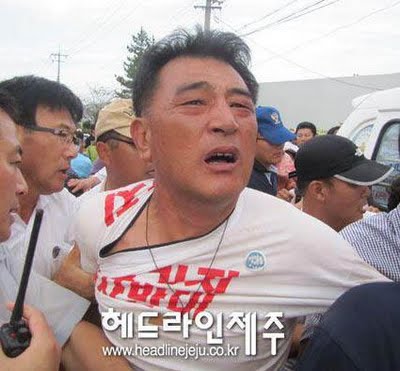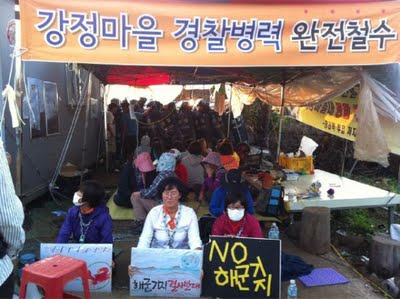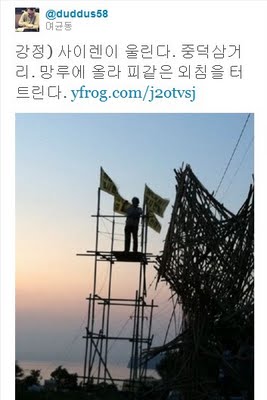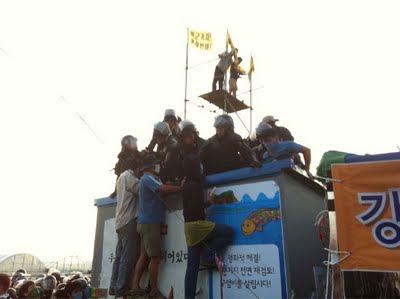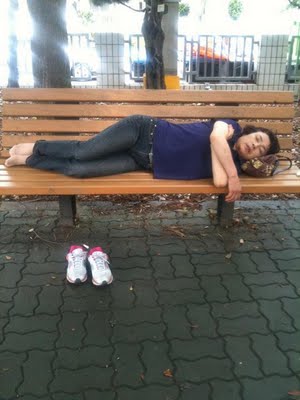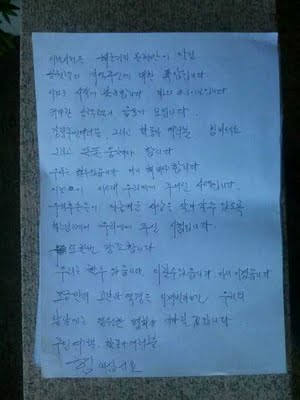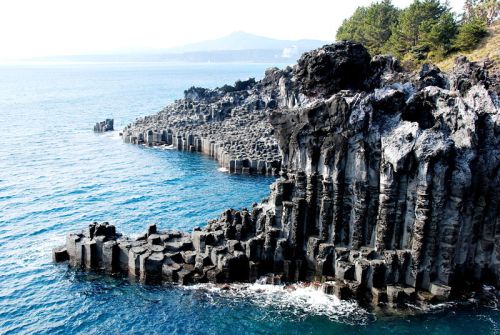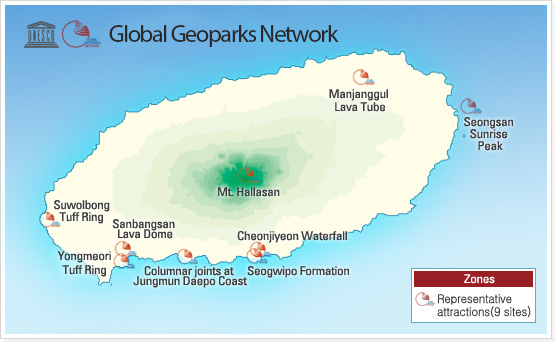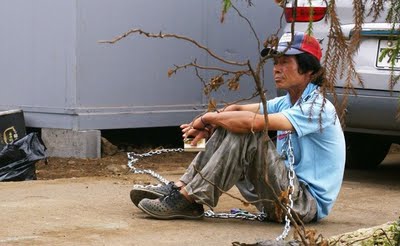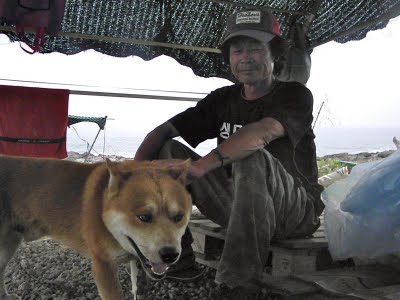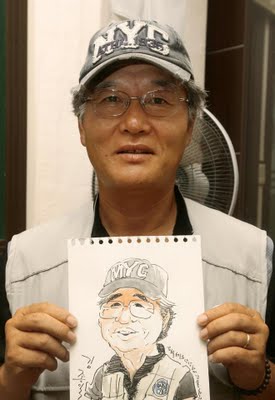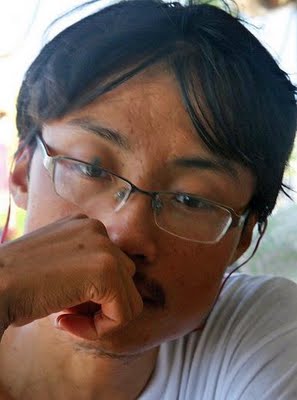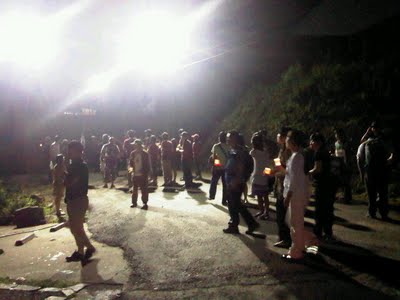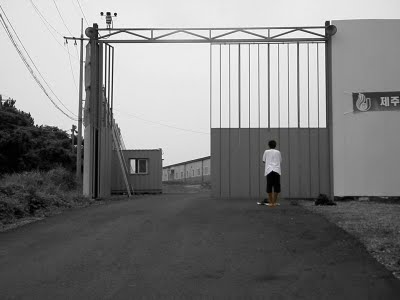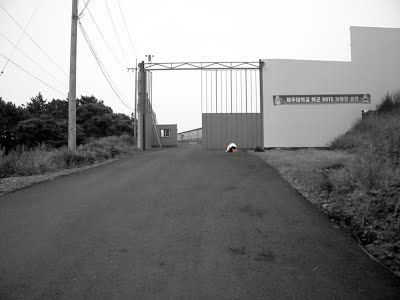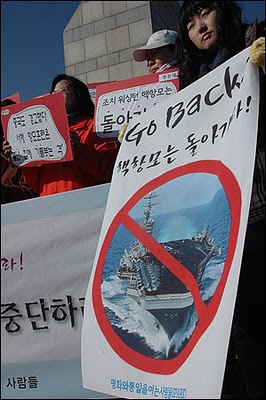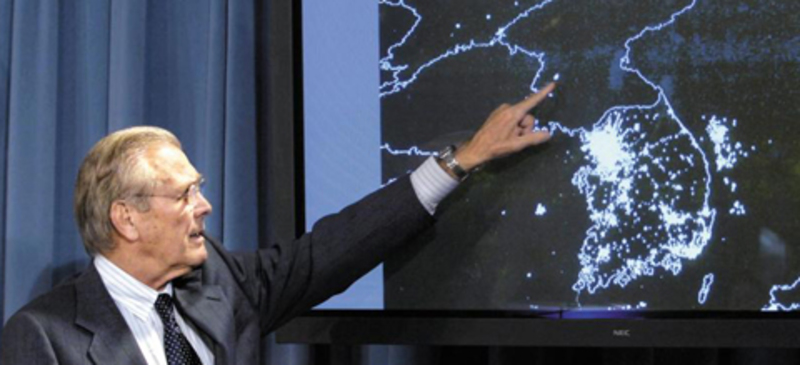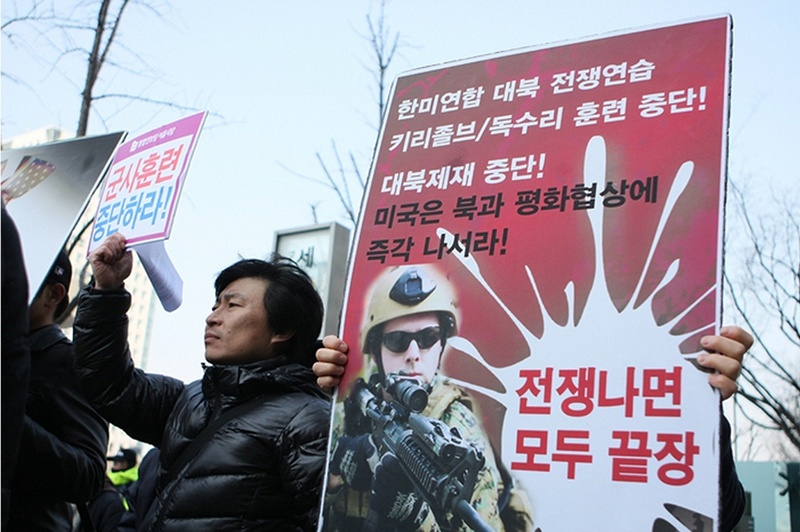|
Save Cheju Island
"Although citizens have engaged in movements for democracy for decades,
repressive governments intent on maintaining privileges for corporations,
have thwarted these movements. South Korea is known for severe state violence
against its citizens, including massacres."
On Aug. 10, 2012, the journalist Jon Letman, writing for
IPS News Service,
Cheju, Letman noted, is an island that features a number of "UNESCO World Heritage sites and numerous other environmental and cultural special status designations." As Sung-Hee Choi, "who has been actively protesting in Gangjeong since 2009," pointed out to Letman, Cheju "is not only ecologically and culturally sensitive, but filled with spiritually important sites." But regardless of this, Cheju is coveted by military planners in Washington. In the context of major geopolitical considerations of the Pentagon and the US government, the island that is located between the Korean peninsula and Japan, is "taking on [a] new strategic importance" for the "United States, which maintains dozens of military bases in South Korea, Japan and Okinawa, v[ying] for dominance in northeast Asia." According to Mr. Letman's unnamed military sources, the new naval base under construction at Gangjeong village will "accommodate submarines and up to 20 warships, including U.S. Aegis-equipped destroyers" Opponents of the base say that this military installation "will make the island less safe, not more," Jon Letman reports, adding that for five years already, Gangjeong [Gangjung] village "has been the site of daily protests and frequent arrests." According to the IPS report, "Samsung is the lead contractor at the base and Hyundai Heavy Industries is working with Lockheed Martin to produce the Aegis Combat System to be deployed on U.S. warships at the Jeju naval base." For many years already, American warships equipped with Tomahawk missiles have been stationed in waters off the Korean coast, in close proximity to such Chinese cities as Tianjin and Beijing. What makes the decision to build the base on Cheju island (despite the ardent opposition of many islanders and of members of the Korean peace movement from the entire country!) so scandalous, is the fact that some of the bloodiest massacres in post-WWII Korean history were committed here on orders of the American military commander stationed on the island. The American officer described Cheju in 1948 as a "red island." In addition to the ROK army and the National Police, he called in the infamous Northwest Corps formed by anti-communist persons who had left the Soviet occupation zone in the North of the country. US troops did not engage in the counter-insurgency campaign, but acted as advisers, watched ongoing massacres, and took photos of massacres. IPS News service notes that these "military massacres" committed on Cheju during the uprising of "1948-1954" resulted in the death of "one-fifth of the population." Kim Hun-joon's book entitled "The Massacres At Mt. Halla. Sixty Years of Truth Seeking in South Korea" provides important information on this bitter experience. Incidentally, quite a few of those who are now protesting against the base that the ROK government wants to put at the disposal of the US Navy, are relatives of those killed in the massacres on Cheju in the late 1940s and early '50s. - The editor.
Jeju Island: What’s at stake? From a history marred by one of Korea’s worst military massacres (1948-1954) in which an estimated one-fifth of the population was killed, to being dubbed an “Island of Peace” in 2006, Jeju is gaining increasing global recognition for its natural beauty, unique geology and rich biodiversity. Jeju island, 80 km southwest of the Korean peninsula, is South Korea’s only Special Self-governing province and the first place in the world to receive all three UNESCO natural science designations (Biosphere Reserve in 2002, World Natural Heritage in 2007 and Global Geopark in 2010). Volcanic Jeju was recently named a New Seven Wonders of Nature site in addition to having a number of other environmental and cultural designations. But conservation and civic groups, NGOs and scientists familiar with Jeju’s fragile ecosystems say the island’s nature and culture are threatened and the Korean peninsula destabilised by the naval base under construction at the southern village of Gangjeong. That base, designed to berth up to 20 warships including U.S. Aegis-equipped destroyers, opponents argue, will imperil rare wildlife, destroy natural areas that currently enjoy special protected status and irrevocably alter local culture and livelihoods. Base opponents from Catholic nuns and scientists to grassroots organisers and even Gangjeong’s mayor himself have been arrested and brought to trial as they decry the destruction of a lava coastline, a rare rocky wetland, freshwater springs and coral reefs which are being blasted and covered with concrete caissons. They point out the rarity of these habitats and list plants and animal whose homes are being irrevocably transformed to make way for the base. These species include bottle-nosed dolphins, narrow-mouthed toads, red-footed crabs, Jeju freshwater shrimp and dozens of species of soft coral. Besides coastal and marine life, critics charge construction of the
base and new military housing is leading to the seizure of farmland and
the end of a hundreds-of-years-old way of life based on farming, fishing
and traditional subsistence diving by Jeju’s iconic haenyo women divers
who symbolise an island people that prided themselves on living in balance
with their environment.
A Cheju villager arrested by the National Police
......Ganjeong [Gangjung] village, on Cheju [Jeju] Island - the site of the new naval base There is an emergency situation in Ganjeong village, Cheju Island since Aug. 24, 2011, as the peace movement struggles against Cheju naval base construction, because of its contribution to further destabilization and increasing danger of war in East Asia. The villagers also fear the environmental damage that is caused by it. Construction of the large base is destroying the habitat of species, impairing the beauty of the coastline, and threatening the livelihood of pearl divers working in waters off the Cheju coast! Has South Korea reverted to Quasi-Military Dictatorship?
Riot Police arrest Jeju Islanders protesting state seizure of farms
RELEASE Kang Dong-Kyun (Gangjeong
village mayor, 54), Kim Jong-Hwan(villager, 54), and Kim Dong-Won(photographer,
25)!
Benj D'Amour says
Sung-Hee Choi says
Tuesday, September 13, 2011 [Jeju Update: Sept. 6] A letter from imprisoned village representative Kang Dongkyun to Noam Chomsky
A letter by imprisoned mayor Kang Dong-Kyun
to Noam Chomsky.
____________________________________________________
Gangjeong Village People's Council Translation by dopehead zo
A letter from imprisoned village representative Kang Dongkyun to Noam
Chomsky
Dear Mr. Noam Chomsky! How are you? I am Kang Dongkyun, the Gangjeong village representative, from Jeju Island where the people have been suffering and fighting for 4 years and 4 months against an unjust construction of a naval base. The decision making process was unjust because the vast majority of the villagers opposed the construction of a naval base. And geographically Gangjeong village is not an appropriate location for a naval base. Despite these problems, the South Korean government and the Ministry of Defence have been pushing forward the project while ignoring its people's will, which created all sorts of conflicts not only within the community but in the whole island. Neighbors are turning their backs on one another, and human relations used to be close but now it's all broken. At this point, Jeju Island is trying hard to be selected as one of the New Seven Wonders of Nature, based on the 3 titles that Jeju Volcanic Island and Gangjeong village have won from the UNESCO; UNESCO Biosphere Reserve, UNESCO World Natural Heritage, and UNESCO Global Geoparks. Our Gangjeong village is proud to meet the qualifications of the 3 UNESCO titles. I think that it is meaningless for the Jeju Island to try to be entitled as one of the new 7 wonders of nature if a naval base comes to Gangjeong village. Jeju Island has two paths to take. One is a militarised Jeju Island that will increase tensions in the region. The other is a peaceful island where the breath-taking beauty of nature is well-preserved so all the peace-loving people from the world come to appreciate the environment. Which one should be the right choice in terms of national interests
and South Korea's status in the world community?
Dear Mr. Noam Chomsky! I have read your writings and support messages. Thank you for helping
us. I can't agree with you more when you say that a rule by force and violence
will fall by the same force. The history proves that.
Dear Mr. Noam Chomsky! We are trying everything we can to keep this small village on Jeju Island. We know and firmly believe that keeping the life and peace of the village ensures the peace on the island, in the country and the whole world. We will never be shaken or surrender to any unjust state power. Peace
maintained by force will be fallen by another big force.
Dear Mr. Noam Chomsky! What we want is a small peace where people live their lives by helping and taking care of each other. We wish to make a true world where beautiful stories can be written by the people. Please help us out and please let us keep the hope. Thank you very much. Sept. 6, 2011 On behalf of the Gangjeong villagers Kang Dongkyun
Posted by NO Base Stories of Korea at 7:36 PM
Stop attack on Gangjeong village on Jeju Dear ROK Embassy Staff: I am sad and angry to hear about the massive police and military attack on the non-violent people of Gangjeong village today on Jeju Island. They are trying to protect their sacred lands, rocks, coral, fishing and farming culture. What could be wrong with them doing that? It is criminal that the ROK government is attacking these villagers. Our organization has been following this case and has been helping to build support for the villagers. This whole situation is making your government look very bad and giving the ROK a bad reputation as a military dictatorship. We demand an end to this persecution of the Gangjeong villagers and end to the plans to build this Navy base. We know that US Navy Aegis destroyers, outfitted with so-called "missile defense" systems, will be ported there as part of the US strategy to surround and "manage" China. ROK government is being drawn into a deadly and provocative US strategy that will only make the Asia-Pacific region more insecure. Listen to your own citizens and stop this Navy base now. In peace, Bruce K. Gagnon
Posted by NO Base Stories of Korea
LET"S EMBRACE TOGETHER GUREOMBEE, THE ROCKY COAST OF GANGJEONG VILLAGE
The police restrained three people since Aug. 24. The navy and construction companies such as Samsung are attempting to continue construction. The police even interrupted the people's peaceful candle vigil since Aug. 28. But determined people will SAVE GANGJEONG and the Gureombee rocky coast, OUR MOTHER, OUR LOVE! Posted by NO Base Stories of Korea at 11:24 AM
On Aug. 24, police illegally attacked the village and arrested five
people. While two are released in that night, the three named below
are still in jail. On Aug. 25 when Father Moon Jung-Hyun tried to save
the restrained by climbing on a police car carrying the three away, he
was arrested, too. He was released the next night. Below is a short description
of who the three are. These [three men] are [two] innocent villagers who
simply wanted to save their hometown and a young photographer who just
wanted to live his life according to justice and consciousness. Living
in South Korea, you can be ‘criminal’ any time if you want to live
your life as a real human being, which is paradoxically guaranteed by the
Constitution. By now, seven people have been restrained during the struggle
against Jeju naval base and four have been released after court judgments
of probation or bail.
Korea Herald
MacGregor Eddy says,
The Kyunghyamg Shinmun, Aug. 29, 2011
Korea Times, Aug. 29, 2011
Paco says on Aug. 30, 2011
Regina says on Aug 30
Korea Times on Aug. 30, 2011
See also articles (* Thanks to Mattew Hoey)
Ten Thousand Things Jeju District Court's Obstruction of Democracy
Yesterday the Jeju District Court granted an injunction to the Navy and the central government to forbid resident demonstrations against the seizure of their homes and farms, and the destruction of one of Jeju Island's most beautiful coasts (South Korea's only natural dolphin habitat) to make way for a massive naval base to house warships meant to intimidate China. The court rejected an application by residents challenging the state seizure, demolition of the coastline, and destruction of the soft coral habitat. The residents argued that the state did not follow democratic due process and and failed to adequately assessment of the environmental damage to the coastline. . The court said the residents and their supporters must not return to the residents' homes and farms, now a state military construction site. People who attempt to return to their property would be fined 2 million won ($1,863). Local residents have been joined by democratic and environmentalist activists and religious leaders from all over Korea. They are supported by environmentalist, democratic, and religious supporters worldwide, including scholars and luminaries such as Gloria Steinem. In a replay of South Korea's worst periods of military dictatorship, the state has sent in hundreds of riot police, who are mostly conscripted youth, most of whom appear confused, embarrassed, and unhappy about having to perpetrate threat of violence or violence upon their fellow citizens. South Korea is similar to North Korea in the authoritarian attitude of the ruling elite; although South Korea is not totalitarian like North Korea. Although citizens have engaged in movements for democracy for decades, repressive governments intent on maintaining privileges for corporations, have thwarted these movements. South Korea is known for severe state violence against its citizens, including massacres. In April, 1948, one of the worst massacres in Korean history took place at Jeju Island. Many of the demonstrators are descendants of that massacre. ________________
Posted by NO Base Stories of Korea
2011년 8월 31일 7시 30분, 강정 마을로부터 오늘 공권력 탄압이 예상된다는 문자 메시지를 받았습니다. We've been notified that at 10 am, policemen will enter to execute their official duty - which is to set up 'warning signs' and extend the fence that blocks the road to the beach. All of us here are preparing for this situation. Please pray for us... On Sept. 1, [2011] police arrested three people including Mr. Kim Jong-Il (SPARK), Mr. Kim Min-Soo, an artist in Gangjeong village, and Ms. Kim Ah-Hyun, one of the key Jeju activists. [When arrested,] Mr. Kim Jong-Il had gone to the Cheju local court to submit an appeal against the court decision upholding the order prohibiting 37 people (originally 76) to access the Cheju naval base construction area. The government had filed a provisional disposition suit against 76 people on July 12, this year. The police excuse was that they had not responded to a police call [to disperse]. The two others were arrested when they were driving a car to the prison to meet the restrained on Aug. 24. Youngsil says, "Mr. Kim Jong-Il is a management team leader here in Gangjeong Village. He went to court to file a suit. When he was leaving the courthouse, 10 members of the police surrounded him to arrest him. Then they took him to Cheju Dongbu police station." "Kim Minsoo is a documentary film director & cartoonist who moved
to Gangjeong village three years ago."(via Facebook)
On Sept. 2, police arrested 38 people as of 2pm. They arrested three
people in the village community hall: Mr. Go Yu-Gi, co-chairman of the
Pan-Island committee to stop the military base on Cheju Island, Mr. Jung
Kyung-Bo and Ms. Kim Mi-Ryang, two Gangjeong villagers. During their raid
on the people's key protest site on the same day, they arrested 35 people.
Among those confirmed are: Three villagers, seven students, two [Catholic]
fathers and one reverend. Also 10 activists from the Island Committee against
the naval base (including Mr. Hong Ki-Ryong, the other co-chairmen of the
committee) and from the group for solidarity with migrant people.
On Sept. 3, despite the South Korean government's recently escalating oppression against the people's peaceful and non-violent protests, people throughout the nation are coming to Gangjeong village to save it and Cheju Island, the Peace Island, from naval base construction. A peace plane carrying at least 170 people from Seoul is expected to come while people here expect that about 2,000 people from all of the nation would gather in the village to celebrate our strong will for peace with lots of cultural & religious events in which all the beings from voiceless creatures to human beings are welcome and invited. During the police raid on Sept. 2, several people had to be rushed to hospital. One person had leg injuries, another needed medical treatment of the skin around his eyes. The latter was x-rayed in hospital, as the skin around eyes was torn open by a police shield. See photos of police violence. (*photos by Dauri) As of Aug. 26, [2011], 7 people have been restrained and three, including Gangjeong village mayor Kang Dong-Kyun, Mr. Kim Jong-Hwan, a Gangjeong villager, and Mr. Kim Dong-Won, a photographer, who were arrested on Aug. 24, have been put in jail., while the other four got probation or bail after their having been arrested since April 9. The Lee Myung-Bak government is enforcing the construction of the Cheju naval base construction by creating a situation worthy of security state, escalating its oppression since the moment the people's resistance started on Aug. 24. Indiscriminate human rights violations are very much a matter of concern [for those engaged] in the struggle against the Cheju naval base construction. More updates and photos will come later. (Source: http://nobasestorieskorea.blogspot.de/ )
Regina Pyon says:
Matt Hoey says,
Dauri says,
Matt Hoey says,
Posted by NO Base Stories of Korea
Many photos thanks to Youngsil, FACEBOOK. .FACEBOOK: SAVE JEJU ISLAND and NO NAVAL BASE ON JEJU 09.02.2011 Clashes erupt at South Korean base site. Protests continue
MSNBC
[The above information material is quoted from the No Base Stories website. It is a selection that attempts to give a brief overview of the early phase of the popular struggle against the base.]
|
.
. |

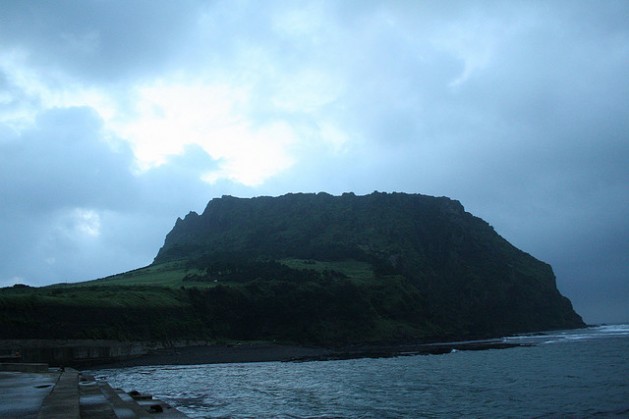
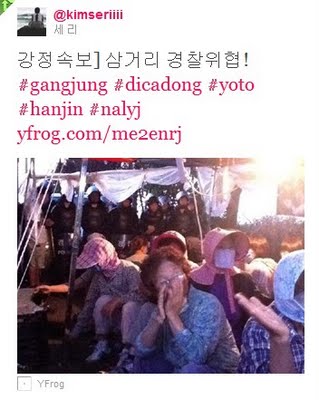
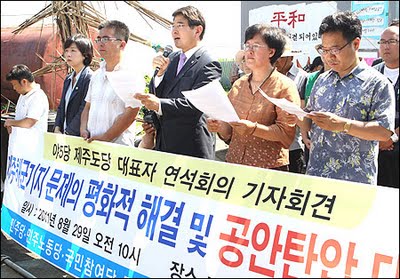
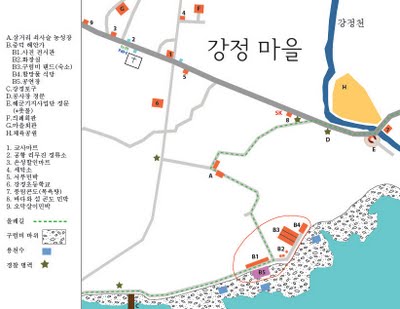
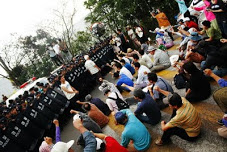
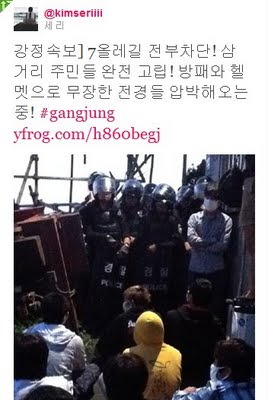
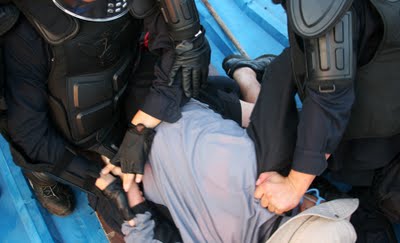
 arrest
arrest
